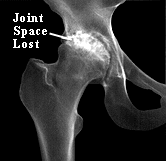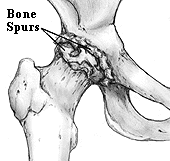

| An X-Ray and Illustration Showing an Arthritic Hip Joint |
|
There are two broad categories of arthritis OSTEOARTHRITIS AND RHEUMATOID ARTHRITIS |
Osteoarthritis mainly damages the joint cartilage, but there is often some inflammation as well. It usually affects only one or two major joints (usually in the legs). It does not affect the internal organs. The cause of hip osteoarthritis is not known. It is thought to be simply a process of wear and tear in most cases. Some conditions may predispose the hip to osteoarthritis, for example, a previous fracture that involved the joint. Growth abnormalities of the hip (such as a shallow socket) may lead to premature arthritis. Some childhood hip problems later cause hip arthritis (for example, a type of childhood hip fracture known as a Slipped Epiphysis; also Legg-PertheŪs Disease). In osteoarthritis of the hip the cartilage cushion is either thinner than normal (leaving bare spots on the bone), or completely absent. Bare bone on the head of the femur grinding against the bone of the pelvic socket causes mechanical pain. Fragments of cartilage floating in the joint may cause inflammation in the joint lining, and this is a second source of pain. X-rays show the žjoint spaceÓ to be narrowed and irregular in outline. There is no blood test for osteoarthritis.
Rheumatoid Arthritis (R.A.) starts in the synovium and is mainly inflammatory. The cause is not known. It eventually destroys the joint cartilage. Bone next to the cartilage is also damaged; it becomes very soft (frequently making the use of an uncemented implant impossible). R.A. affects multiple joints simultaneously. It also affects internal organs. Another form of hip arthritis that is mainly inflammatory is Lupus. There are other more rare forms of arthritis that are also mainly žinflammatoryÓ. They are basically similar to R.A.. X-ray changes in R.A. are essentially similar to osteoarthritis plus a loss of bone density.
Blood tests for rheumatoid arthritis are not very accurate. Rheumatoid Factor is present in the blood in about 80% of patients who have had rheumatoid arthritis for more than 18 months. Early on in the disease the percentage is much lower. Unfortunately, about 7% of people over the age of 70 test positive for rheumatoid factor, even though they do not have rheumatoid arthritis. The test, by itself, is therefore not very reliable.
Anti-inflammatory medications are effective in treating the inflammatory aspect of either rheumatoid or osteoarthritis.
Osteonecrosis is another serious cause of hip pain. It is not arthritis. It is a condition in which part of the femoral head dies. This dead bone can not stand up to the stresses of walking, the femoral head collapses, and becomes irregular in shape. The joint then becomes painful. The most common causes of osteonecrosis are excessive alcohol use and excessive use of cortisone-containing medications.